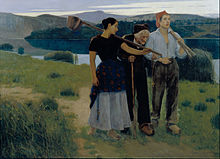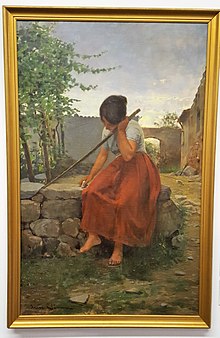Joan Llimona i Bruguera


Joan Llimona i Bruguera (born June 23, 1860 in Barcelona , † February 23, 1926 there ) was a Catalan painter of realism. His deep Christian religiosity was reflected in his artistic work in the form of a sentimental realism that sometimes came close to a mysticism. His younger brother was the sculptor Josep Llimona i Bruguera .
education
After dropping out of engineering and architecture, Llimona studied at the Llotja , the art school of Barcelona, and painting in Rome. From 1880 to 1882 he accompanied his younger brother Josep to study in Rome. In 1882 he took part in a collective exhibition in Barcelona. In 1884 he published some drawings in the magazine L'Avenç . Around 1890, his pictures met with great admiration in Barcelona's leading gallery, Sala Parés . From 1891 his name as an important naturalistic painter had established itself - despite his apologetic image Christ venç (Christ conquers). This work marks the end of his conversion process to Catholicism. This work received strong criticism from the well-known art critic Raimon Casellas . His conversion to Catholicism led him to lead a Catholic group within the nascent modernist movement. Out of this group, the Cercle Artístic de Sant Lluc (Artists' Circle of Saint Luke) was founded in 1893 . In 1896 his work Tornant del tros (Return from the Field) won a gold medal at the Fine Arts Exhibition in Barcelona.
Religious painting
From 1896 to 1898, Llimona decorated the dome of the altar chapel of the Black Madonna of Montserrat in the Montserrat Monastery . Due to its completely authentic naturalism, this work is considered an outstanding example of a renovation in religious Catalan art. In 1902 Llimona also painted the frieze in the Church of the Sisters of the Poor in Vic and in 1904 the dome of the Carmelite Church in the monastery residence El Escorial and the dome of another church in Vic. After these two works, Llimona was strongly influenced by symbolism , which he always put in the service of his religious painting. In this way he designed the dining room in the Recollons house in Barcelona in 1905 . He created more large-scale religious works of art as 1912 the canopy of Ripoll in today's Archives and Museum of Ripoll , 1902 the cloister in the Barcelo Neser Church San Felip Neri and 1923 the Holy shrine in Loreto Sanctuary of Bràfim . The latter two works were destroyed in the iconoclastic turmoil of 1936 just before and at the beginning of the Spanish Civil War. Llimona had given the features of Antoni Gaudí to Saint Philip Neri in Barcelona .
Working in society
Llimona was also an outstanding draftsman and poster painter. He was President of the Lliga del Bon Mot (League of Good Words ) and President of the Foment de Pietat Catalana (Sponsors of Piety). He frequently published articles in magazines such as La Barretina , La Veu de Catalunya (The Voice of Catalonia), Catalunya Social and other periodicals. In it he wrote about aesthetics in general. But he also criticized with obsessive emphasis eroticism and blasphemy as the source of all evil. These essays by Llimona were published in 1930 in the anthological collection El dot de Deu (The Gift of God).
Rating
Llimona often took the position of an intolerant, sometimes even violent artistic puritanism. For example, he threw Auguste Rodin's nudes on the trash, which were presented at an international art exhibition in Barcelona in 1907. Despite these attitudes and actions, his painting led to a refreshment of Catalan naturalism. The art of Llimona brought a contrast to the brilliant but often stereotypical painting of anecdotes by Marià Fortuny . It thus occupies an important position in modernist painting in Catalonia.
Personal
Joan Llimona was the son of the musician Josep Llimona i Bonafont , who was in business at the same time as the Can Barnau cord factory . His brother Alfons continued to run the factory, while Joan and his brother Josep chose the visual arts as their field of activity. Joan Llimona was married to Pilar de Gisbert's first marriage. From this marriage there were six children. In the second marriage Llimona was married to Maria Raymat. This marriage resulted in four children, including the Catalan children's author Mercè Llimona i Raymat and the Catalan painter Núria Llimona i Raymat . Joan Llimona was indirectly related to the Spanish pianist and composer Enrique Granados through the marriage of his daughter Mercè to a son . Joan Llimona was the maternal grandfather of the Catalan draftsman and painter Joan Granados i Llimona .
literature
- Enciclopèdia Catalana: Llimona i Bruguera, Joan . In: Gran enciclopèdia catalana. 2nd edition 5th reprint 1992. Volume 14 . Enciclopèdia catalana, Barcelona 1987, ISBN 84-7739-011-8 , p. 81 f . (Catalan).
- Hèlios Rubio et al .: Art de Catalunya (Ars Cataloniae) . Josep Llimona i Bruguera. 1st edition. tape 7 /16 (Escultura moderna i Contemporània). Edicions L'Isard, Barcelona 1998, ISBN 84-89931-03-8 , pp. 179-181 .
Web links
- Enciclopedia.cat: Joan Llimona i Bruguera. Retrieved March 6, 2018 (Catalan).
- Coleccion Carmen Thyssen-Bornemisza: Joan Llimona i Bruguera. Archived from the original on February 6, 2020 ; Retrieved March 7, 2018 (Spanish).
- Museu Nacional d'Art de Catalunya: Joan and Josep Llimona i Bruguera. Archived from the original on March 7, 2018 ; Retrieved March 6, 2018 (Catalan).
- trianarts.com: Joan Llimona and Catalan modernism and mysticism. February 23, 2018, archived from the original on February 23, 2020 ; Retrieved March 6, 2018 (Catalan).
Individual references and comments
- ↑ after Saint Philip Neri.
- ↑ Information from the family history based on: Núria Rius Vernet (Diccionari biogràfic de dones): Mercè Llimona i Raymat (biography). Generalitat de Catalunya, Consell de Mallorca, Xarxa Vives d'Universitats, October 2, 2010, accessed June 16, 2018 (Catalan).
- ↑ Generalitat de Catalunya: Mercè Llimona i Bruguera. Retrieved May 31, 2018 (Catalan).
| personal data | |
|---|---|
| SURNAME | Llimona i Bruguera, Joan |
| BRIEF DESCRIPTION | Catalan painter |
| DATE OF BIRTH | February 23, 1860 |
| PLACE OF BIRTH | Barcelona |
| DATE OF DEATH | June 23, 1926 |
| Place of death | Barcelona |

